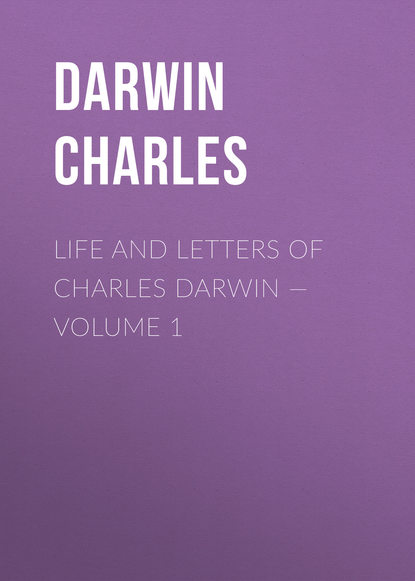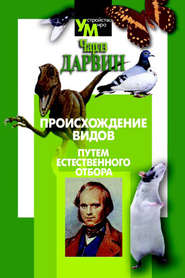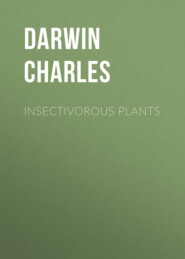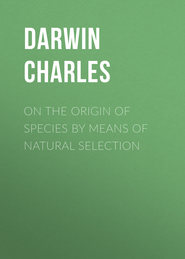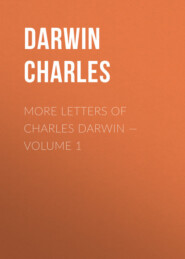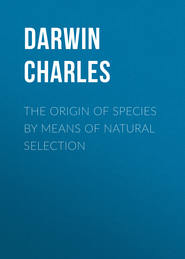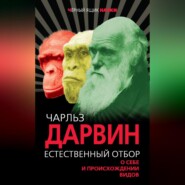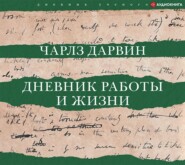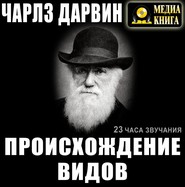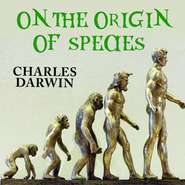По всем вопросам обращайтесь на: info@litportal.ru
(©) 2003-2025.
✖
Life and Letters of Charles Darwin — Volume 1
Настройки чтения
Размер шрифта
Высота строк
Поля
But in the following note we get extinction connected with unfavourable variation, and thus a hint is given of natural selection:
"With respect to extinction, we can easily see that [a] variety of [the] ostrich (Petise), may not be well adapted, and thus perish out; or, on the other hand, like Orpheus [a Galapagos bird], being favourable, many might be produced. This requires [the] principle that the permanent variations produced by confined breeding and changing circumstances are continued and produced according to the adaptation of such circumstance, and therefore that death of species is a consequence (contrary to what would appear from America) of non-adaptation of circumstances."
The first part of the next extract has a similar bearing. The end of the passage is of much interest, as showing that he had at this early date visions of the far-reaching character of the theory of evolution: —
"With belief of transmutation and geographical grouping, we are lead to endeavour to discover CAUSES of change; the manner of adaptation (wish of parents??), instinct and structure becomes full of speculation and lines of observation. View of generation being condensation (I imagine him to mean that each generation is "condensed" to a small number of the best organized individuals.) test of highest organisation intelligible...My theory would give zest to recent and fossil comparative anatomy; it would lead to the study of instincts, heredity, and mind-heredity, whole [of] metaphysics.
"It would lead to closest examination of hybridity and generation, causes of change in order to know what we have come from and to what we tend — to what circumstances favour crossing and what prevents it — this, and direct examination of direct passages of structure in species, might lead to laws of change, which would then be [the] main object of study, to guide our speculations."
The following two extracts have a similar interest; the second is especially interesting, as it contains the germ of concluding sentence of the 'Origin of Species': ('Origin of Species' (1st edition), page 490: — "There is a grandeur in this view of life, with its several powers, having been originally breathed into a few forms or into one; and that whilst this planet has gone cycling on according to the fixed law of gravity, from so simple a beginning endless forms most beautiful and most wonderful have been, and are being evolved.") —
"Before the attraction of gravity discovered it might have been said it was as great a difficulty to account for the movement of all [planets] by one law, as to account for each separate one; so to say that all mammalia were born from one stock, and since distributed by such means as we can recognise, may be thought to explain nothing.
"Astronomers might formerly have said that God fore-ordered each planet to move in its particular destiny. In the same manner God orders each animal created with certain forms in certain countries, but how much more simple and sublime [a] power — let attraction act according to certain law, such are inevitable consequences — let animals be created, then by the fixed laws of generation, such will be their successors.
"Let the powers of transportal be such, and so will be the forms of one country to another — let geological changes go at such a rate, so will be the number and distribution of the species!!"
The three next extracts are of miscellaneous interest: —
"When one sees nipple on man's breast, one does not say some use, but sex not having been determined — so with useless wings under elytra of beetles — born from beetles with wings, and modified — if simple creation merely, would have been born without them."
"In a decreasing population at any one moment fewer closely related (few species of genera); ultimately few genera (for otherwise the relationship would converge sooner), and lastly, perhaps, some one single one. Will not this account for the odd genera with few species which stand between great groups, which we are bound to consider the increasing ones?"
The last extract which I shall quote gives the germ of his theory of the relation between alpine plants in various parts of the world, in the publication of which he was forestalled by E. Forbes (see volume i. page 72). He says, in the 1837 note-book, that alpine plants, "formerly descended lower, therefore [they are] species of lower genera altered, or northern plants."
When we turn to the Sketch of his theory, written in 1844 (still therefore before the second edition of the 'Journal' was completed), we find an enormous advance made on the note-book of 1837. The Sketch is an fact a surprisingly complete presentation of the argument afterwards familiar to us in the 'Origin of Species.' There is some obscurity as to the date of the short Sketch which formed the basis of the 1844 Essay. We know from his own words (volume i., page 68), that it was in June 1842 that he first wrote out a short sketch of his views. (This version I cannot find, and it was probably destroyed, like so much of his MS., after it had been enlarged and re-copied in 1844.) This statement is given with so much circumstance that it is almost impossible to suppose that it contains an error of date. It agrees also with the following extract from his Diary.
1842. May 18th. Went to Maer.
"June 15th to Shrewsbury, and on 18th to Capel Curig. During my stay at Maer and Shrewsbury (five years after commencement) wrote pencil-sketch of species theory."
Again in the introduction to the 'Origin,' page 1, he writes, "after an interval of five years' work" [from 1837, i.e. in 1842], "I allowed myself to speculate on the subject, and drew up some short notes."
Nevertheless in the letter signed by Sir C. Lyell and Sir J.D. Hooker, which serves as an introduction to the joint paper of Messrs. C. Darwin and A. Wallace on the 'Tendency of Species to form Varieties,' ('Linn. Soc. Journal,' 1858, page 45.) the essay of 1844 (extracts from which form part of the paper) is said to have been "sketched in 1839, and copied in 1844." This statement is obviously made on the authority of a note written in my father's hand across the Table of Contents of the 1844 Essay. It is to the following effect: "This was sketched in 1839, and copied out in full, as here written and read by you in 1844." I conclude that this note was added in 1858, when the MS. was sent to Sir J.D. Hooker (see Letter of June 29, 1858, page 476). There is also some further evidence on this side of the question. Writing to Mr. Wallace (January 25, 1859) my father says: — "Every one whom I have seen has thought your paper very well written and interesting. It puts my extracts (written in 1839, now just twenty years ago!), which I must say in apology were never for an instant intended for publication; into the shade." The statement that the earliest sketch was written in 1839 has been frequently made in biographical notices of my father, no doubt on the authority of the 'Linnean Journal,' but it must, I think, be considered as erroneous. The error may possibly have arisen in this way. In writing on the Table of Contents of the 1844 MS. that it was sketched in 1839, I think my father may have intended to imply that the framework of the theory was clearly thought out by him at that date. In the Autobiography he speaks of the time, "about 1839, when the theory was clearly conceived," meaning, no doubt, the end of 1838 and beginning of 1839, when the reading of Malthus had given him the key to the idea of natural selection. But this explanation does not apply to the letter to Mr. Wallace; and with regard to the passage (My father certainly saw the proofs of the paper, for he added a foot-note apologising for the style of the extracts, on the ground that the "work was never intended for publication.") in the 'Linnean Journal' it is difficult to understand how it should have been allowed to remain as it now stands, conveying, as it clearly does, the impression that 1839 was the date of his earliest written sketch.
The sketch of 1844 is written in a clerk's hand, in two hundred and thirty-one pages folio, blank leaves being alternated with the MS. with a view to amplification. The text has been revised and corrected, criticisms being pencilled by himself on the margin. It is divided into two parts: I. "On the variation of Organic Beings under Domestication and in their Natural State." II. "On the Evidence favourable and opposed to the view that Species are naturally formed races descended from common Stocks." The first part contains the main argument of the 'Origin of Species.' It is founded, as is the argument of that work, on the study of domestic animals, and both the Sketch and the 'Origin' open with a chapter on variation under domestication and on artificial selection. This is followed, in both essays, by discussions on variation under nature, on natural selection, and on the struggle for life. Here, any close resemblance between the two essays with regard to arrangement ceases. Chapter III. of the Sketch, which concludes the first part, treats of the variations which occur in the instincts and habits of animals, and thus corresponds to some extent with Chapter VII. of the 'Origin' (1st edition). It thus forms a complement to the chapters which deal with variation in structure. It seems to have been placed thus early in the Essay to prevent the hasty rejection of the whole theory by a reader to whom the idea of natural selection acting on instincts might seem impossible. This is the more probable, as the Chapter on Instinct in the 'Origin' is specially mentioned (Introduction, page 5) as one of the "most apparent and gravest difficulties on the theory." Moreover the chapter in the Sketch ends with a discussion, "whether any particular corporeal structures...are so wonderful as to justify the rejection prima facie of our theory." Under this heading comes the discussion of the eye, which in the 'Origin' finds its place in Chapter VI. under "Difficulties of the Theory." The second part seems to have been planned in accordance with his favourite point of view with regard to his theory. This is briefly given in a letter to Dr. Asa Gray, November 11th, 1859: "I cannot possibly believe that a false theory would explain so many classes of facts, as I think it certainly does explain. On these grounds I drop my anchor, and believe that the difficulties will slowly disappear." On this principle, having stated the theory in the first part, he proceeds to show to what extent various wide series of facts can be explained by its means.
Thus the second part of the Sketch corresponds roughly to the nine concluding Chapters of the First Edition of the 'Origin.' But we must exclude Chapter VII. ('Origin') on Instinct, which forms a chapter in the first part of the Sketch, and Chapter VIII. ('Origin') on Hybridism, a subject treated in the Sketch with 'Variation under Nature' in the first part.
The following list of the chapters of the second part of the Sketch will illustrate their correspondence with the final chapters of the 'Origin.'
Chapter I. "On the kind of intermediateness necessary, and the number
of such intermediate forms." This includes a geological discussion, and corresponds to parts of Chapters VI. and IX. of the 'Origin.'
Chapter II. "The gradual appearance and disappearance of organic
beings." Corresponds to Chapter X. of the 'Origin.'
Chapter III. "Geographical Distribution." Corresponds to Chapters XI
and XII. of the 'Origin.'
Chapter IV. "Affinities and Classification of Organic beings."
Chapter V. "Unity of Type," Morphology, Embryology
Chapter VI. Rudimentary Organs
These three chapters correspond to Chapter XII. of the 'Origin.'
Chapter VII. Recapitulation and Conclusion. The final sentence of the
Sketch, which we saw in its first rough form in the Note Book of 1837, closely resembles the final sentence of the 'Origin,' much of it being identical. The 'Origin' is not divided into two "Parts," but we see traces of such a division having been present in the writer's mind, in this resemblance between the second part of the Sketch and the final chapters of the 'Origin.' That he should speak ('Origin,' Introduction, page 5.) of the chapters on transition, on instinct, on hybridism, and on the geological record, as forming a group, may be due to the division of his early MS. into two parts.
Mr. Huxley, who was good enough to read the Sketch at my request, while remarking that the "main lines of argument," and the illustrations employed are the same, points out that in the 1844 Essay, "much more weight is attached to the influence of external conditions in producing variation, and to the inheritance of acquired habits than in the Origin.'"
It is extremely interesting to find in the Sketch the first mention of principles familiar to us in the 'Origin of Species.' Foremost among these may be mentioned the principle of Sexual Selection, which is clearly enunciated. The important form of selection known as "unconscious," is also given. Here also occurs a statement of the law that peculiarities tend to appear in the offspring at an age corresponding to that at which they occurred in the parent.
Professor Newton, who was so kind as to look through the 1844 Sketch, tells me that my father's remarks on the migration of birds, incidentally given in more than one passage, show that he had anticipated the views of some later writers.
With regard to the general style of the Sketch, it is not to be expected that it should have all the characteristics of the 'Origin,' and we do not, in fact, find that balance and control, that concentration and grasp, which are so striking in the work of 1859.
In the Autobiography (page 68, volume 1) my father has stated what seemed to him the chief flaw of the 1844 Sketch; he had overlooked "one problem of great importance," the problem of the divergence of character. This point is discussed in the 'Origin of Species,' but, as it may not be familiar to all readers, I will give a short account of the difficulty and its solution. The author begins by stating that varieties differ from each other less than species, and then goes on: "Nevertheless, according to my view, varieties are species in process of formation...How then does the lesser difference between varieties become augmented into the greater difference between species?" ('Origin,' 1st edition, page 111.) He shows how an analogous divergence takes place under domestication where an originally uniform stock of horses has been split up into race-horses, dray-horses, etc., and then goes on to explain how the same principle applies to natural species. "From the simple circumstance that the more diversified the descendants from any one species become in structure, constitution, and habits, by so much will they be better enabled to seize on many and widely diversified places in the polity of nature, and so be enabled to increase in numbers."
The principle is exemplified by the fact that if on one plot of ground a single variety of wheat be sown, and on to another a mixture of varieties, in the latter case the produce is greater. More individuals have been able to exist because they were not all of the same variety. An organism becomes more perfect and more fitted to survive when by division of labour the different functions of life are performed by different organs. In the same way a species becomes more efficient and more able to survive when different sections of the species become differentiated so as to fill different stations.
In reading the Sketch of 1844, I have found it difficult to recognise the absence of any definite statement of the principle of divergence as a flaw in the Essay. Descent with modification implies divergence, and we become so habituated to a belief in descent, and therefore in divergence, that we do not notice the absence of proof that divergence is in itself an advantage. As shown in the Autobiography, my father in 1876 found it hardly credible that he should have overlooked the problem and its solution.
The following letter will be more in place here than its chronological position, since it shows what was my father's feeling as to the value of the Sketch at the time of its completion.]
CHARLES DARWIN TO MRS. DARWIN. Down, July 5, 1844.
I have just finished my sketch of my species theory. If, as I believe, my theory in time be accepted even by one competent judge, it will be a considerable step in science.
I therefore write this in case of my sudden death, as my most solemn and last request, which I am sure you will consider the same as if legally entered in my will, that you will devote 400 pounds to its publication, and further, will yourself, or through Hensleigh (Mr. H. Wedgwood.), take trouble in promoting it. I wish that my sketch be given to some competent person, with this sum to induce him to take trouble in its improvement and enlargement. I give to him all my books on Natural History, which are either scored or have references at the end to the pages, begging him carefully to look over and consider such passages as actually bearing, or by possibility bearing, on this subject. I wish you to make a list of all such books as some temptation to an editor. I also request that you will hand over [to] him all those scraps roughly divided in eight or ten brown paper portfolios. The scraps, with copied quotations from various works, are those which may aid my editor. I also request that you, or some amanuensis, will aid in deciphering any of the scraps which the editor may think possibly of use. I leave to the editor's judgment whether to interpolate these facts in the text, or as notes, or under appendices. As the looking over the references and scraps will be a long labour, and as the CORRECTING and enlarging and altering my sketch will also take considerable time, I leave this sum of 400 pounds as some remuneration, and any profits from the work. I consider that for this the editor is bound to get the sketch published either at a publisher's or his own risk. Many of the scrap in the portfolios contains mere rude suggestions and early views, now useless, and many of the facts will probably turn out as having no bearing on my theory.
With respect to editors, Mr. Lyell would be the best if he would undertake it; I believe he would find the work pleasant, and he would learn some facts new to him. As the editor must be a geologist as well as a naturalist, the next best editor would be Professor Forbes of London. The next best (and quite best in many respects) would be Professor Henslow. Dr. Hooker would be VERY good. The next, Mr. Strickland. (After Mr. Strickland's name comes the following sentence, which has been erased but remained legible. "Professor Owen would be very good; but I presume he would not undertake such a work." If none of these would undertake it, I would request you to consult with Mr. Lyell, or some other capable man for some editor, a geologist and naturalist. Should one other hundred pounds make the difference of procuring a good editor, request earnestly that you will raise 500 pounds.)
My remaining collections in Natural History may be given to any one or any museum where it would be accepted...
[The following note seems to have formed part of the original letter, but may have been of later date:
"Lyell, especially with the aid of Hooker (and of any good zoological aid), would be best of all. Without an editor will pledge himself to give up time to it, it would be of no use paying such a sum.
"If there should be any difficulty in getting an editor who would go thoroughly into the subject, and think of the bearing of the passages marked in the books and copied out of scraps of paper, then let my sketch be published as it is, stating that it was done several years ago (The words "several years ago and," seem to have been added at a later date.) and from memory without consulting any works, and with no intention of publication in its present form."
The idea that the Sketch of 1844 might remain, in the event of his death, as the only record of his work, seems to have been long in his mind, for in August 1854, when he had finished with the Cirripedes, and was thinking of beginning his "species work," he added on the back of the above letter, "Hooker by far best man to edit my species volume. August 1854."]
"With respect to extinction, we can easily see that [a] variety of [the] ostrich (Petise), may not be well adapted, and thus perish out; or, on the other hand, like Orpheus [a Galapagos bird], being favourable, many might be produced. This requires [the] principle that the permanent variations produced by confined breeding and changing circumstances are continued and produced according to the adaptation of such circumstance, and therefore that death of species is a consequence (contrary to what would appear from America) of non-adaptation of circumstances."
The first part of the next extract has a similar bearing. The end of the passage is of much interest, as showing that he had at this early date visions of the far-reaching character of the theory of evolution: —
"With belief of transmutation and geographical grouping, we are lead to endeavour to discover CAUSES of change; the manner of adaptation (wish of parents??), instinct and structure becomes full of speculation and lines of observation. View of generation being condensation (I imagine him to mean that each generation is "condensed" to a small number of the best organized individuals.) test of highest organisation intelligible...My theory would give zest to recent and fossil comparative anatomy; it would lead to the study of instincts, heredity, and mind-heredity, whole [of] metaphysics.
"It would lead to closest examination of hybridity and generation, causes of change in order to know what we have come from and to what we tend — to what circumstances favour crossing and what prevents it — this, and direct examination of direct passages of structure in species, might lead to laws of change, which would then be [the] main object of study, to guide our speculations."
The following two extracts have a similar interest; the second is especially interesting, as it contains the germ of concluding sentence of the 'Origin of Species': ('Origin of Species' (1st edition), page 490: — "There is a grandeur in this view of life, with its several powers, having been originally breathed into a few forms or into one; and that whilst this planet has gone cycling on according to the fixed law of gravity, from so simple a beginning endless forms most beautiful and most wonderful have been, and are being evolved.") —
"Before the attraction of gravity discovered it might have been said it was as great a difficulty to account for the movement of all [planets] by one law, as to account for each separate one; so to say that all mammalia were born from one stock, and since distributed by such means as we can recognise, may be thought to explain nothing.
"Astronomers might formerly have said that God fore-ordered each planet to move in its particular destiny. In the same manner God orders each animal created with certain forms in certain countries, but how much more simple and sublime [a] power — let attraction act according to certain law, such are inevitable consequences — let animals be created, then by the fixed laws of generation, such will be their successors.
"Let the powers of transportal be such, and so will be the forms of one country to another — let geological changes go at such a rate, so will be the number and distribution of the species!!"
The three next extracts are of miscellaneous interest: —
"When one sees nipple on man's breast, one does not say some use, but sex not having been determined — so with useless wings under elytra of beetles — born from beetles with wings, and modified — if simple creation merely, would have been born without them."
"In a decreasing population at any one moment fewer closely related (few species of genera); ultimately few genera (for otherwise the relationship would converge sooner), and lastly, perhaps, some one single one. Will not this account for the odd genera with few species which stand between great groups, which we are bound to consider the increasing ones?"
The last extract which I shall quote gives the germ of his theory of the relation between alpine plants in various parts of the world, in the publication of which he was forestalled by E. Forbes (see volume i. page 72). He says, in the 1837 note-book, that alpine plants, "formerly descended lower, therefore [they are] species of lower genera altered, or northern plants."
When we turn to the Sketch of his theory, written in 1844 (still therefore before the second edition of the 'Journal' was completed), we find an enormous advance made on the note-book of 1837. The Sketch is an fact a surprisingly complete presentation of the argument afterwards familiar to us in the 'Origin of Species.' There is some obscurity as to the date of the short Sketch which formed the basis of the 1844 Essay. We know from his own words (volume i., page 68), that it was in June 1842 that he first wrote out a short sketch of his views. (This version I cannot find, and it was probably destroyed, like so much of his MS., after it had been enlarged and re-copied in 1844.) This statement is given with so much circumstance that it is almost impossible to suppose that it contains an error of date. It agrees also with the following extract from his Diary.
1842. May 18th. Went to Maer.
"June 15th to Shrewsbury, and on 18th to Capel Curig. During my stay at Maer and Shrewsbury (five years after commencement) wrote pencil-sketch of species theory."
Again in the introduction to the 'Origin,' page 1, he writes, "after an interval of five years' work" [from 1837, i.e. in 1842], "I allowed myself to speculate on the subject, and drew up some short notes."
Nevertheless in the letter signed by Sir C. Lyell and Sir J.D. Hooker, which serves as an introduction to the joint paper of Messrs. C. Darwin and A. Wallace on the 'Tendency of Species to form Varieties,' ('Linn. Soc. Journal,' 1858, page 45.) the essay of 1844 (extracts from which form part of the paper) is said to have been "sketched in 1839, and copied in 1844." This statement is obviously made on the authority of a note written in my father's hand across the Table of Contents of the 1844 Essay. It is to the following effect: "This was sketched in 1839, and copied out in full, as here written and read by you in 1844." I conclude that this note was added in 1858, when the MS. was sent to Sir J.D. Hooker (see Letter of June 29, 1858, page 476). There is also some further evidence on this side of the question. Writing to Mr. Wallace (January 25, 1859) my father says: — "Every one whom I have seen has thought your paper very well written and interesting. It puts my extracts (written in 1839, now just twenty years ago!), which I must say in apology were never for an instant intended for publication; into the shade." The statement that the earliest sketch was written in 1839 has been frequently made in biographical notices of my father, no doubt on the authority of the 'Linnean Journal,' but it must, I think, be considered as erroneous. The error may possibly have arisen in this way. In writing on the Table of Contents of the 1844 MS. that it was sketched in 1839, I think my father may have intended to imply that the framework of the theory was clearly thought out by him at that date. In the Autobiography he speaks of the time, "about 1839, when the theory was clearly conceived," meaning, no doubt, the end of 1838 and beginning of 1839, when the reading of Malthus had given him the key to the idea of natural selection. But this explanation does not apply to the letter to Mr. Wallace; and with regard to the passage (My father certainly saw the proofs of the paper, for he added a foot-note apologising for the style of the extracts, on the ground that the "work was never intended for publication.") in the 'Linnean Journal' it is difficult to understand how it should have been allowed to remain as it now stands, conveying, as it clearly does, the impression that 1839 was the date of his earliest written sketch.
The sketch of 1844 is written in a clerk's hand, in two hundred and thirty-one pages folio, blank leaves being alternated with the MS. with a view to amplification. The text has been revised and corrected, criticisms being pencilled by himself on the margin. It is divided into two parts: I. "On the variation of Organic Beings under Domestication and in their Natural State." II. "On the Evidence favourable and opposed to the view that Species are naturally formed races descended from common Stocks." The first part contains the main argument of the 'Origin of Species.' It is founded, as is the argument of that work, on the study of domestic animals, and both the Sketch and the 'Origin' open with a chapter on variation under domestication and on artificial selection. This is followed, in both essays, by discussions on variation under nature, on natural selection, and on the struggle for life. Here, any close resemblance between the two essays with regard to arrangement ceases. Chapter III. of the Sketch, which concludes the first part, treats of the variations which occur in the instincts and habits of animals, and thus corresponds to some extent with Chapter VII. of the 'Origin' (1st edition). It thus forms a complement to the chapters which deal with variation in structure. It seems to have been placed thus early in the Essay to prevent the hasty rejection of the whole theory by a reader to whom the idea of natural selection acting on instincts might seem impossible. This is the more probable, as the Chapter on Instinct in the 'Origin' is specially mentioned (Introduction, page 5) as one of the "most apparent and gravest difficulties on the theory." Moreover the chapter in the Sketch ends with a discussion, "whether any particular corporeal structures...are so wonderful as to justify the rejection prima facie of our theory." Under this heading comes the discussion of the eye, which in the 'Origin' finds its place in Chapter VI. under "Difficulties of the Theory." The second part seems to have been planned in accordance with his favourite point of view with regard to his theory. This is briefly given in a letter to Dr. Asa Gray, November 11th, 1859: "I cannot possibly believe that a false theory would explain so many classes of facts, as I think it certainly does explain. On these grounds I drop my anchor, and believe that the difficulties will slowly disappear." On this principle, having stated the theory in the first part, he proceeds to show to what extent various wide series of facts can be explained by its means.
Thus the second part of the Sketch corresponds roughly to the nine concluding Chapters of the First Edition of the 'Origin.' But we must exclude Chapter VII. ('Origin') on Instinct, which forms a chapter in the first part of the Sketch, and Chapter VIII. ('Origin') on Hybridism, a subject treated in the Sketch with 'Variation under Nature' in the first part.
The following list of the chapters of the second part of the Sketch will illustrate their correspondence with the final chapters of the 'Origin.'
Chapter I. "On the kind of intermediateness necessary, and the number
of such intermediate forms." This includes a geological discussion, and corresponds to parts of Chapters VI. and IX. of the 'Origin.'
Chapter II. "The gradual appearance and disappearance of organic
beings." Corresponds to Chapter X. of the 'Origin.'
Chapter III. "Geographical Distribution." Corresponds to Chapters XI
and XII. of the 'Origin.'
Chapter IV. "Affinities and Classification of Organic beings."
Chapter V. "Unity of Type," Morphology, Embryology
Chapter VI. Rudimentary Organs
These three chapters correspond to Chapter XII. of the 'Origin.'
Chapter VII. Recapitulation and Conclusion. The final sentence of the
Sketch, which we saw in its first rough form in the Note Book of 1837, closely resembles the final sentence of the 'Origin,' much of it being identical. The 'Origin' is not divided into two "Parts," but we see traces of such a division having been present in the writer's mind, in this resemblance between the second part of the Sketch and the final chapters of the 'Origin.' That he should speak ('Origin,' Introduction, page 5.) of the chapters on transition, on instinct, on hybridism, and on the geological record, as forming a group, may be due to the division of his early MS. into two parts.
Mr. Huxley, who was good enough to read the Sketch at my request, while remarking that the "main lines of argument," and the illustrations employed are the same, points out that in the 1844 Essay, "much more weight is attached to the influence of external conditions in producing variation, and to the inheritance of acquired habits than in the Origin.'"
It is extremely interesting to find in the Sketch the first mention of principles familiar to us in the 'Origin of Species.' Foremost among these may be mentioned the principle of Sexual Selection, which is clearly enunciated. The important form of selection known as "unconscious," is also given. Here also occurs a statement of the law that peculiarities tend to appear in the offspring at an age corresponding to that at which they occurred in the parent.
Professor Newton, who was so kind as to look through the 1844 Sketch, tells me that my father's remarks on the migration of birds, incidentally given in more than one passage, show that he had anticipated the views of some later writers.
With regard to the general style of the Sketch, it is not to be expected that it should have all the characteristics of the 'Origin,' and we do not, in fact, find that balance and control, that concentration and grasp, which are so striking in the work of 1859.
In the Autobiography (page 68, volume 1) my father has stated what seemed to him the chief flaw of the 1844 Sketch; he had overlooked "one problem of great importance," the problem of the divergence of character. This point is discussed in the 'Origin of Species,' but, as it may not be familiar to all readers, I will give a short account of the difficulty and its solution. The author begins by stating that varieties differ from each other less than species, and then goes on: "Nevertheless, according to my view, varieties are species in process of formation...How then does the lesser difference between varieties become augmented into the greater difference between species?" ('Origin,' 1st edition, page 111.) He shows how an analogous divergence takes place under domestication where an originally uniform stock of horses has been split up into race-horses, dray-horses, etc., and then goes on to explain how the same principle applies to natural species. "From the simple circumstance that the more diversified the descendants from any one species become in structure, constitution, and habits, by so much will they be better enabled to seize on many and widely diversified places in the polity of nature, and so be enabled to increase in numbers."
The principle is exemplified by the fact that if on one plot of ground a single variety of wheat be sown, and on to another a mixture of varieties, in the latter case the produce is greater. More individuals have been able to exist because they were not all of the same variety. An organism becomes more perfect and more fitted to survive when by division of labour the different functions of life are performed by different organs. In the same way a species becomes more efficient and more able to survive when different sections of the species become differentiated so as to fill different stations.
In reading the Sketch of 1844, I have found it difficult to recognise the absence of any definite statement of the principle of divergence as a flaw in the Essay. Descent with modification implies divergence, and we become so habituated to a belief in descent, and therefore in divergence, that we do not notice the absence of proof that divergence is in itself an advantage. As shown in the Autobiography, my father in 1876 found it hardly credible that he should have overlooked the problem and its solution.
The following letter will be more in place here than its chronological position, since it shows what was my father's feeling as to the value of the Sketch at the time of its completion.]
CHARLES DARWIN TO MRS. DARWIN. Down, July 5, 1844.
I have just finished my sketch of my species theory. If, as I believe, my theory in time be accepted even by one competent judge, it will be a considerable step in science.
I therefore write this in case of my sudden death, as my most solemn and last request, which I am sure you will consider the same as if legally entered in my will, that you will devote 400 pounds to its publication, and further, will yourself, or through Hensleigh (Mr. H. Wedgwood.), take trouble in promoting it. I wish that my sketch be given to some competent person, with this sum to induce him to take trouble in its improvement and enlargement. I give to him all my books on Natural History, which are either scored or have references at the end to the pages, begging him carefully to look over and consider such passages as actually bearing, or by possibility bearing, on this subject. I wish you to make a list of all such books as some temptation to an editor. I also request that you will hand over [to] him all those scraps roughly divided in eight or ten brown paper portfolios. The scraps, with copied quotations from various works, are those which may aid my editor. I also request that you, or some amanuensis, will aid in deciphering any of the scraps which the editor may think possibly of use. I leave to the editor's judgment whether to interpolate these facts in the text, or as notes, or under appendices. As the looking over the references and scraps will be a long labour, and as the CORRECTING and enlarging and altering my sketch will also take considerable time, I leave this sum of 400 pounds as some remuneration, and any profits from the work. I consider that for this the editor is bound to get the sketch published either at a publisher's or his own risk. Many of the scrap in the portfolios contains mere rude suggestions and early views, now useless, and many of the facts will probably turn out as having no bearing on my theory.
With respect to editors, Mr. Lyell would be the best if he would undertake it; I believe he would find the work pleasant, and he would learn some facts new to him. As the editor must be a geologist as well as a naturalist, the next best editor would be Professor Forbes of London. The next best (and quite best in many respects) would be Professor Henslow. Dr. Hooker would be VERY good. The next, Mr. Strickland. (After Mr. Strickland's name comes the following sentence, which has been erased but remained legible. "Professor Owen would be very good; but I presume he would not undertake such a work." If none of these would undertake it, I would request you to consult with Mr. Lyell, or some other capable man for some editor, a geologist and naturalist. Should one other hundred pounds make the difference of procuring a good editor, request earnestly that you will raise 500 pounds.)
My remaining collections in Natural History may be given to any one or any museum where it would be accepted...
[The following note seems to have formed part of the original letter, but may have been of later date:
"Lyell, especially with the aid of Hooker (and of any good zoological aid), would be best of all. Without an editor will pledge himself to give up time to it, it would be of no use paying such a sum.
"If there should be any difficulty in getting an editor who would go thoroughly into the subject, and think of the bearing of the passages marked in the books and copied out of scraps of paper, then let my sketch be published as it is, stating that it was done several years ago (The words "several years ago and," seem to have been added at a later date.) and from memory without consulting any works, and with no intention of publication in its present form."
The idea that the Sketch of 1844 might remain, in the event of his death, as the only record of his work, seems to have been long in his mind, for in August 1854, when he had finished with the Cirripedes, and was thinking of beginning his "species work," he added on the back of the above letter, "Hooker by far best man to edit my species volume. August 1854."]





